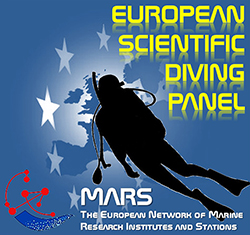The requirement to establish standard competencies throughout Europe was foreseen, and in the late 1980’s scientists who used diving in their research sought to initiate the harmonization of the rules and procedures for scientific diving in Europe (European Scientific Diving ad hoc committee). This is closely related to the reflection and construction of minimum standards for initial training in underwater diving for the use of scientists (see related page), recognised in the member states.
In 2000, during the final meeting of that group in Banyuls-sur-Mer, France, this effort finally resulted in the development of two European scientific diving standards: that of European Scientific Diver (ESD), and of Advanced European Scientific Diver (AESD). The ESD and AESD do not include any regulations such as insurance, medical examinations, employment rules, safety rules, diving limits, rules for recognition of national scientific diving schools, etc. These are covered by national law and European Directives. Neither do the ESD and AESD take account of any specialty requirements by employers. They simply define the minimum basic training of a scientific diver as needed for mobility (see footnote 1) and as a basic training level on which the employer can build further training modules.
In 2000, the European Union (EU) created the European Research Area with the intention of forming a unified area across Europe that would enable researchers to move and interact seamlessly based on a series of aligned working directives. The EU research network presently consists of 33 countries made up of the EU member states (27 countries) plus an additional 6 non-EU member countries that have associated status. The challenge for European scientific diving has been to integrate existing national programs through a single organizational structure that supports the promotion of recognized diving standards within European science while advancing the wider acceptance of diving as a research tool.
In 2007, leading scientists who employ scientific diving techniques within eight European countries (UK, France, Sweden, Finland, Poland, Italy, Belgium, and Germany) started an EU-wide initiative to establish a pan-European platform to support scientific diving. As well as promoting and enhancing scientific excellence within the field of diving-supported aquatic research, the initiative also sought to establish harmonized rules and guidelines. Based on two international workshops in Berlin and Bremerhaven, Germany in 2007, the European Scientific Diving Committee (ESDC) was established and formally constituted in October 2007 in Bremerhaven. The ESDC was based on the principle of promoting the European Scientific Diver (ESD) and the Advanced European Scientific Diver (AESD) competencies as the primary European scientific diving standards.
In October 2008, scientific diving in Europe was accepted to become an approved Panel of the Marine Board of the European Science Foundation. Scientific diving in Europe will, therefore, from now on be overseen by the Marine Board – European Scientific Diving Panel (MB-ESDP). ESF panels are not perennial structures. They are assumed not to last more than 4 years. However, in view of the need for harmonization of SD in Europe and the results achieved, the MB supported the ESDP until April 2017. Currently, ESDP is under the umbrella of the European network of marine stations – MARS (a foundation created by, and open to, Europe’s marine research institutes and stations).
